
Sunnyside (1835) is an historic house on 10 acres along the Hudson River, in Tarrytown, New York. It was the home of the American author Washington Irving, best known for his short stories, such as "Rip Van Winkle" (1819) and "The Legend of Sleepy Hollow" (1820).
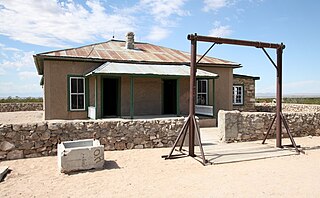
The McDonald Ranch House in the Oscura Mountains of Socorro County, New Mexico, was the location of assembly of the world's first nuclear weapon. The active components of the Trinity test "gadget", a plutonium Fat Man-type bomb similar to that later dropped on Nagasaki, Japan, were assembled there on July 13, 1945. The completed bomb was winched up the test tower the following day and detonated on July 16, 1945, as the Trinity nuclear test.

The Lake McDonald Lodge is a historic lodge located within Glacier National Park, on the southeast shore of Lake McDonald. The lodge is a 3+1⁄2-story structure built in 1913 based on Kirtland Cutter's design. The foundation and first floor walls are built of stone, with a wood-frame superstructure. The lobby is a large, open space that extends to the third story. It has a massive fireplace and a concrete floor scored in a flagstone pattern, with messages in several Indian languages inscribed into it. The rustic lodge was designated a National Historic Landmark in 1987 as one of the nation's finest examples of large-scale Swiss chalet architecture. Lake McDonald Lodge is a member of Historic Hotels of America, the official program of the National Trust for Historic Preservation.

The Lake McDonald Lodge Historic District is a historic district in Glacier National Park in the U.S. state of Montana. It comprises the Lake McDonald Lodge and surrounding structures on the shores of Lake McDonald. It is centered on the main lodge, which was designated a National Historic Landmark in 1987, as well as surrounding guest cabins, dormitory buildings, employee residences, utility buildings, and retail structures. The district includes several privately owned inholding structures that are contributing structures, as well as a number of non-contributing buildings.
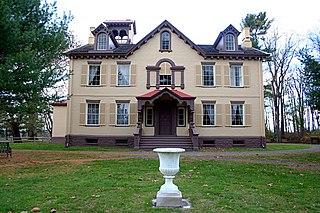
Martin Van Buren National Historic Site is a unit of the United States National Park Service in Columbia County, New York, 1 mile (1.6 km) south of the village of Kinderhook, 125 miles (201 km) north of New York City and 20 miles (32 km) south of Albany. The National Historic Site preserves the Lindenwald estate owned by Martin Van Buren, the eighth president of the United States. Van Buren purchased the 36-room mansion during his presidency in 1839, and it became his home and farm from his leaving office in 1841 until his death in 1862.
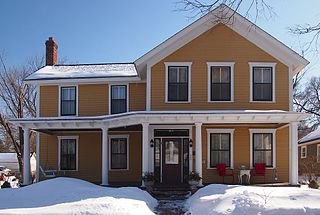
The MacDonald–Todd House is an 1857 home in Hastings in the U.S. state of Minnesota. The Greek Revival-style house was built by A.W. MacDonald in the utopian town of Nininger when he relocated to Dakota County from New York. He came to become the managing editor of the Emigrant Aid Journal. The paper was owned by Lieutenant Governor Ignatius Donnelly, who also founded the community of Nininger. In 1866, the home was moved across the ice in the Mississippi River to its present location, by Irving Todd, who had bought it for $385.

The Donald McKay House is a privately owned historic house at 78–80 White Street in East Boston, Massachusetts. It was the residence of Donald McKay, a builder of clipper ships.

The Bernard Ginsburg House is a single-family private residence located in Midtown Detroit, Michigan, within the Brush Park district. It was listed on the National Register of Historic Places in 1991.

This is a list of the National Register of Historic Places listings in Le Sueur County, Minnesota. It is intended to be a complete list of the properties and districts on the National Register of Historic Places in Le Sueur County, Minnesota, United States. The locations of National Register properties and districts for which the latitude and longitude coordinates are included below, may be seen in an online map.

Paradise Park Historic District is located in Thomasville, Georgia. It was listed on the National Register of Historic Places 1984 with an increase in 2002. It consists of Thomasville's Paradise Park, and properties including 15 contributing buildings and one non-contributing building.

The Dr. Kuno Struck House, also known as Clifton Manor, is a historic building located in the West End of Davenport, Iowa, United States. It was individually listed on the National Register of Historic Places in 1984, and on the Davenport Register of Historic Properties in 1996. The house, along with its garage, became a part of the Marycrest College campus and they were both listed as contributing properties in the Marycrest College Historic District in 2004.
The McDonald Ranch is a historic ranch complex located 14 miles (23 km) southwest of Chugwater in Laramie County, Wyoming. Donald McDonald, a Scottish immigrant, founded the ranch in 1881. McDonald developed his ranch using his personal savings, which was uncommon in a region where most ranches could draw upon outside capital or inheritances. However, his ranch became one of the most successful in northern Laramie County; by McDonald's death in 1925, the ranch was worth over $180,000 and had acquired portions of three other major ranches.
McDonald Brothers founded in 1878 was a Louisville-based firm of architects of courthouses and other public buildings. It was a partnership of brothers Kenneth McDonald, Harry McDonald, and Donald McDonald.
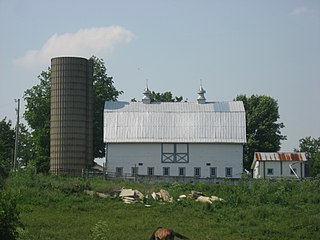
The McDonald Farm is a historic agricultural complex near the city of Xenia in Greene County, Ohio, United States. It has been named a historic site, largely because of a quarry on the farm, which supplied stone for the Washington Monument.
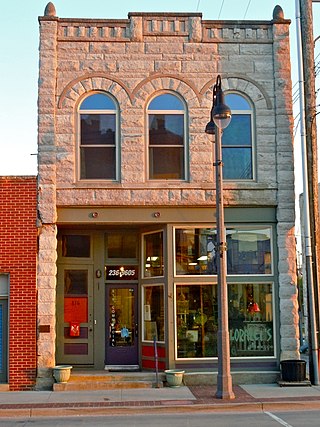
The Bowers and McDonald Office Building is a historic structure located in Grinnell, Iowa, United States. J.B. Bowers and M.W. McDonald had the building built as a speculative real-estate venture.
The McDonald House is a historic residence located west of Winterset, Iowa, United States. William and Barbara McDonald settled in Madison County during the Civil War, and bought this farm in the 1870s. Although not as early as others in the county, this house is a good example of a vernacular limestone farmhouse. This 1½-story structure is composed of locally quarried stone. Its construction is attributed to David Harris, who was one of the last stonemasons still working in the county when this was built. It follows an asymmetrical massed rectangular plan, and it is built on a slightly raised basement. It features two-against-one broken bond, and textured stone characteristic of Harris' work. The house was listed on the National Register of Historic Places in 1993.

The Ethan Allen Engine Company No. 4 is a historic former fire and police station at 135 Church Street in Burlington, Vermont, United States. Built in 1887 for a private fire company, it is a fine local example of 19th-century commercial architecture. It served the city as a fire and police station until the 1960s, and is now used as a commercial space. It was listed on the National Register of Historic Places in 1971, and is a contributing property to the City Hall Park Historic District.
The Diamond A Ranch, or Spring Ranch, is a ranch in the upper Wind River valley of Fremont County, Wyoming. The site was first settled by John Robert McDonald, a Scottish immigrant who had a 160-acre (65 ha) homestead on the site in 1891. McDonald sold the property to John Williamson in 1907. Jack Williamson and his brother David were Scots as well, working as stonemasons. The Williamsons had worked in New York City, at Princeton University, at the Mormon Temple in Salt Lake City and on bridge work for the Union Pacific Railroad. In 1888 they came from Salt Lake City to Lander, where they worked on a number of projects, as well as in Rawlins and at Fort Washakie. They joined their sister Jean Williamson Sinclair at the Upper Circle Ranch near Dubois in the early 1890s. David Williamson married Annie McKenzie, a friend of his sister's who had come with her from Scotland. When Jack died of tick fever in 1916, David moved to the ranch with his family. After David's death in 1934, his wife Annie operated the ranch until she sold it in 1966. The ranch is notable as one of several ranches established by Scottish immigrants.

The Henry County Courthouse, Jail, and Warden's House in New Castle, Kentucky was built in 1875. It was designed by the McDonald Brothers in a mix of Italianate, Second Empire, and other styles. It was listed on the National Register of Historic Places in 1977.

















